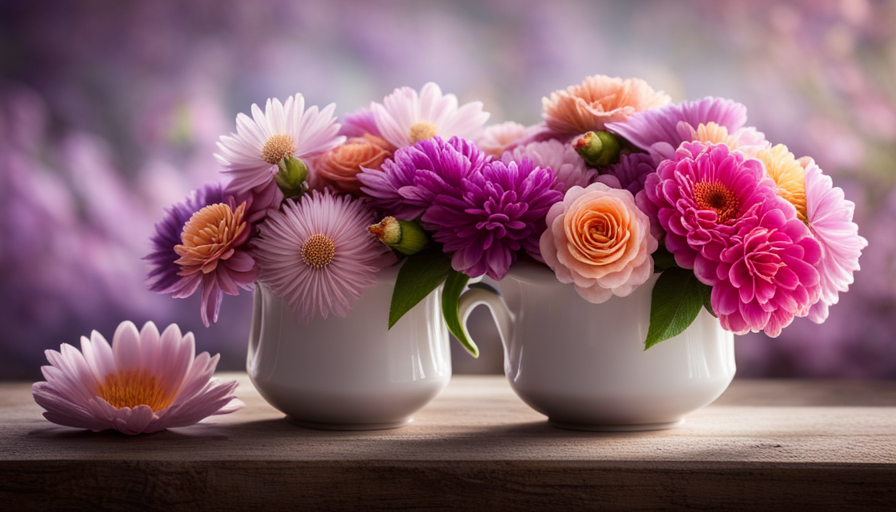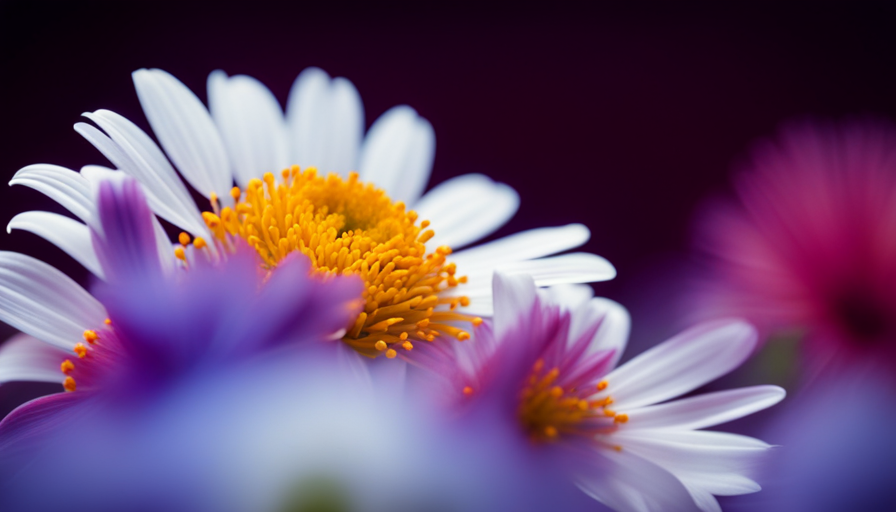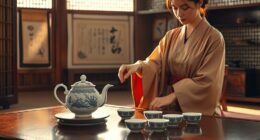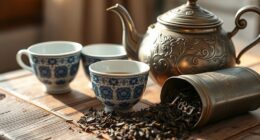Have you ever thought about the magical healing abilities that nature’s beautiful flowers hold? Let me uncover the captivating realm of linden flower tea. Made from the blooms of the linden tree, this plant-based drink has been valued for generations for its incredible wellness advantages. Dive into the wonders of linden flower tea and experience its amazing benefits for yourself!
As I sip on a warm cup of this exquisite tea, I am reminded of the ancient wisdom and healing traditions that have been passed down through generations. From its origins in Europe and Asia to its widespread popularity today, linden flower tea has captivated the hearts and minds of tea enthusiasts all over the world.
Join me as we embark on a journey to explore the origins, nutritional profile, preparation techniques, and even its potential benefits for skincare. So, sit back, relax, and let the soothing aroma and delicate flavors of linden flower tea transport you to a world of tranquility and wellness.
Key Takeaways
- Linden flower tea is derived from the blossoms of the linden tree and has been cherished for centuries for its health benefits.
- It has cultural significance in Europe and has been used as a traditional remedy for anxiety, insomnia, and digestive issues.
- Linden flower tea is rich in antioxidants, anti-inflammatory, and immune-boosting properties.
- It can promote relaxation, reduce tension, and alleviate symptoms of anxiety.
Origins and History of Linden Flower Tea
Do you ever wonder about the rich origins and fascinating history of linden flower tea? Well, let me enlighten you.
This delightful tea has a long and storied past, with its origins dating back to ancient civilizations. The linden tree, also known as the lime tree, is native to Europe and has been revered for its beauty and medicinal properties for centuries.
Linden flower tea holds great cultural significance in many countries, particularly in Europe. It’s been used as a traditional remedy for various ailments, such as anxiety, insomnia, and digestive issues. The soothing properties of linden flowers have made it a popular choice for promoting relaxation and improving sleep quality.
Furthermore, linden flower tea is known for its numerous health benefits. It’s rich in antioxidants, which help protect the body against harmful free radicals. Additionally, it contains compounds that have anti-inflammatory and immune-boosting properties. Regular consumption of linden flower tea may also aid in reducing blood pressure and improving heart health.
Now that we’ve explored the origins and cultural significance of linden flower tea, let’s delve into its impressive health benefits.
Health Benefits of Linden Flower Tea
Linden flower tea offers numerous health benefits, including stress and anxiety relief. This herbal infusion has soothing effects on the nervous system, promoting relaxation and calmness.
Additionally, it can help improve sleep quality, making it an excellent choice for those seeking a natural remedy for insomnia.
Stress and anxiety relief
Feeling stressed or anxious? Sip on a cup of linden flower tea and let its calming properties soothe your mind. As someone who’s tried various stress management techniques and natural remedies for anxiety, I can confidently say that linden flower tea is a game changer.
This herbal infusion has been used for centuries to promote relaxation and reduce tension. The active compounds found in linden flowers help regulate stress hormones and induce a sense of tranquility. Scientific research has shown that linden flower tea can effectively alleviate symptoms of anxiety, such as restlessness and irritability. Its soothing effects on the nervous system make it a wonderful addition to any stress relief routine.
Transitioning into the subsequent section, linden flower tea also has numerous benefits for overall well-being.
Soothing effects on the nervous system
Experience the calming and soothing effects of linden flower tea as it gently relaxes your nervous system, promoting a sense of tranquility and well-being.
-
The bioactive compounds found in linden flower tea, such as flavonoids and volatile oils, have been shown to have stress-relieving properties by reducing cortisol levels in the body.
-
Linden flower tea acts as a natural sleep aid, helping to improve the quality of your sleep. Its sedative properties help to calm the mind and promote relaxation, making it easier to fall asleep and stay asleep throughout the night.
-
Additionally, linden flower tea contains antioxidants that protect the body against oxidative stress, which can contribute to anxiety and other nervous system disorders. These antioxidants help to reduce inflammation and promote a healthy nervous system.
Transitioning into the next section, linden flower tea not only promotes better sleep and relaxation but also offers a range of other health benefits.
Promotes better sleep and relaxation
Sip on this soothing beverage before bed, and you’ll find yourself drifting off into a peaceful slumber in no time. Linden flower tea promotes sleep and relaxation due to its calming effects on the nervous system. It contains compounds that help to reduce anxiety and stress, allowing your body and mind to unwind.
Incorporating linden flower tea into your bedtime routine can be a helpful addition to relaxation techniques such as deep breathing or meditation. The gentle aroma and comforting taste of linden flower tea can create a sense of tranquility, making it the perfect beverage to wind down with at the end of a long day.
Transitioning into the subsequent section about the nutritional profile of linden flowers, it’s important to understand the various health benefits that this tea can provide.
Nutritional Profile of Linden Flowers
To truly appreciate the nutritional benefits of linden flowers, you’ll be amazed at how this delicate blossom packs a powerful punch in terms of vitamins and minerals. Here’s a breakdown of the key nutrients found in linden flowers:
-
Vitamin C: Linden flowers are rich in vitamin C, which plays a vital role in supporting a healthy immune system. Consuming linden flower tea can help boost your body’s defenses and protect against illnesses.
-
Antioxidants: These flowers are also abundant in antioxidants, such as flavonoids and phenolic compounds. These antioxidants help fight off harmful free radicals and reduce oxidative stress, promoting overall health and well-being.
-
Essential Oils: Linden flowers contain essential oils that have calming and soothing properties. These oils can aid in relaxation, reducing stress, and promoting better sleep.
-
Weight Loss Support: Linden flower tea has been linked to weight loss due to its ability to improve digestion and metabolism. It can aid in the breakdown of fats and promote a feeling of fullness, helping to control appetite and support weight management.
With such a nutritional profile, it’s no wonder that linden flower tea has gained popularity for its potential benefits in weight loss and immune system support. Now, let’s explore how to prepare this herbal tea and unlock its full potential.
How to Prepare Linden Flower Tea
Get ready to discover the simple and enjoyable way you can harness the potential health benefits of this delicate blossom – are you curious to learn how to prepare a soothing and nutritious beverage from linden flowers? Preparing linden flower tea is a straightforward process that requires only a few simple steps. First, gather about 2 tablespoons of dried linden flowers. Place the flowers in a teapot or a heat-resistant container. Next, bring 2 cups of water to a boil and pour it over the flowers. Allow the mixture to steep for about 10 minutes, or until the water takes on a golden hue. Finally, strain the liquid into a cup, add a touch of honey if desired, and enjoy the calming aroma and taste of linden flower tea.
Benefits of linden flower tea for sleep have been well-documented. The tea contains compounds that have sedative properties, helping to promote relaxation and improve sleep quality. Linden flowers also have a mild diuretic effect, which can help reduce fluid retention and relieve bloating. Additionally, linden flower tea is rich in antioxidants, which can help protect the body against harmful free radicals and reduce inflammation.
Transition: Now that you know how to prepare this soothing and nutritious beverage, let’s dive into the flavor profile and aroma of linden flower tea.
Flavor Profile and Aroma of Linden Flower Tea
After learning how to prepare Linden Flower Tea, let’s dive into its flavor profile and aroma. This delicate herbal infusion offers a unique taste that’s both floral and slightly sweet. The aroma is reminiscent of fresh flowers, with hints of honey and citrus notes.
The flavor characteristics of Linden Flower Tea can vary depending on the quality of the flowers and the brewing techniques used. When brewing Linden Flower Tea, it’s important to use water that’s just below boiling point, around 190°F (88°C), to preserve its delicate flavors. Steep the tea for about 5 minutes to extract the full range of flavors. The resulting brew will have a light golden color and a smooth, mellow taste.
The floral notes of Linden Flower Tea are complemented by a subtle sweetness that lingers on the palate. It’s a refreshing and soothing beverage, perfect for relaxation and unwinding after a long day. The natural sweetness of the tea makes it enjoyable without the need for any additional sweeteners.
As we explore the benefits of Linden Flower Tea for digestive health, let’s uncover how this herbal infusion can aid in improving our overall well-being.
Linden Flower Tea and Digestive Health
Linden flower tea has soothing effects on the digestive system, making it a great remedy for digestive discomfort. It can help alleviate symptoms of indigestion, such as stomach pain, bloating, and gas. The tea’s natural compounds work to relax the muscles of the digestive tract, promoting healthy digestion and reducing inflammation.
Soothing effects on the digestive system
Take a sip of this fragrant tea made from linden flowers, and let its soothing effects gently calm your digestive system.
Linden flower tea has been used for centuries to alleviate menstrual cramps and reduce inflammation in the gut. The tea contains flavonoids and volatile oils that have anti-inflammatory properties, helping to ease the discomfort and pain associated with menstrual cramps.
Additionally, linden flower tea can help reduce inflammation in the gut, promoting better digestion and alleviating symptoms of indigestion and bloating. Its natural compounds work to relax the muscles of the digestive tract, allowing food to move through more easily and preventing the buildup of gas.
Soothing and gentle, linden flower tea is a natural remedy that can promote digestive health and relieve discomfort.
Alleviating symptoms of indigestion and bloating
To ease the unpleasant symptoms of indigestion and bloating, sip on this soothing stomach solution. Linden flower tea has been used for centuries to alleviate digestive issues, and it can provide relief in several ways:
- Reducing inflammation in the digestive system
- Promoting healthy digestion and preventing constipation
- Alleviating menstrual cramps and reducing pain
- Acting as a diuretic, helping to eliminate excess water weight
- Supporting weight loss by boosting metabolism
The soothing properties of linden flower tea can calm an upset stomach and relieve bloating. It’s also believed to have antispasmodic effects, which can help relax the muscles of the digestive tract and alleviate discomfort. Additionally, linden flower tea can be beneficial for those looking to manage their weight or alleviate menstrual cramps.
Moving on to the next section about linden flower tea and skin care, this herbal infusion offers a range of benefits for your skin as well.
Linden Flower Tea and Skin Care
Pamper yourself with the soothing benefits of linden flower tea for your skin. This delicate herbal infusion offers numerous skin benefits, including its anti-aging effects.
Linden flower tea contains antioxidants that help protect the skin from damage caused by free radicals, which can contribute to premature aging. These antioxidants also have anti-inflammatory properties that can help reduce redness and irritation, making it a great choice for sensitive skin.
The anti-aging effects of linden flower tea are further enhanced by its ability to promote collagen production. Collagen is a protein that gives our skin its elasticity and firmness. As we age, collagen production naturally declines, leading to the formation of wrinkles and sagging skin. By drinking linden flower tea regularly, you can support collagen synthesis and maintain a more youthful appearance.
To enjoy the skin benefits of linden flower tea, simply steep a tea bag or a teaspoon of dried linden flowers in hot water for about 5-7 minutes. You can then use the cooled tea as a facial toner or soak a cotton pad in it and apply it to your face.
It’s important to note that linden flower tea is generally safe for most people, but it’s always a good idea to patch test it on a small area of your skin first to check for any potential allergies or sensitivities. Transitioning into the next section about safety precautions and potential side effects, it’s important to be aware of the possible risks associated with linden flower tea.
Safety Precautions and Potential Side Effects
Before incorporating linden flower tea into your skincare routine, it’s important to be aware of potential side effects and take necessary safety precautions to ensure a positive experience.
Linden flower tea is generally considered safe for most people when consumed in moderate amounts. However, it’s important to note that some individuals may be sensitive or allergic to linden flowers, which could lead to adverse reactions such as skin irritation or respiratory issues.
Additionally, linden flower tea may interact with certain medications, including sedatives, anticoagulants, and anti-inflammatory drugs. It’s crucial to consult with a healthcare professional before using linden flower tea if you’re taking any medications to avoid any potential risks or drug interactions.
To ensure your safety and maximize the benefits of linden flower tea, it’s recommended to follow these safety precautions:
- Start with a small amount and gradually increase the dosage to assess your tolerance.
- Avoid linden flower tea if you’re pregnant or breastfeeding, as its safety in these cases hasn’t been well-studied.
- If you experience any adverse reactions or discomfort after consuming linden flower tea, discontinue use and consult a healthcare professional.
Understanding the potential risks and taking necessary safety precautions will help you make informed decisions about incorporating linden flower tea into your skincare routine. In the next section, we’ll explore other uses and applications of linden flowers.
Other Uses and Applications of Linden Flowers
In addition to its safety precautions and potential side effects, I’d like to discuss the other uses and applications of linden flowers.
Firstly, linden flowers are commonly used in culinary practices and recipes. They can be infused into teas, added to desserts, or even used as a garnish.
Secondly, linden flowers have a long history in herbal remedies and alternative medicine. They’re believed to have calming and soothing properties, making them a popular choice for treating anxiety, insomnia, and digestive issues.
Overall, linden flowers offer a wide range of possibilities in both the culinary and medicinal realms.
Culinary uses and recipes
Linden flower tea can add a delightful floral note to a variety of culinary creations, from delicate pastries to refreshing beverages. When used in cooking, linden flowers offer numerous culinary benefits. They can enhance the flavor profile of desserts like cakes, cookies, and ice creams, infusing them with a subtle floral aroma.
Additionally, linden flowers can be steeped in hot water to make a fragrant syrup, which can be drizzled over pancakes or used to sweeten cocktails.
In traditional recipes, linden flower tea is often used as a natural flavoring agent in jams, jellies, and sauces. Its delicate taste pairs well with fruits like strawberries, peaches, and cherries, adding a unique twist to classic recipes. The flowers can also be used to make linden-infused honey, which can be enjoyed on toast or used as a sweetener in tea.
Transitioning into the next section about herbal remedies and alternative medicine, linden flowers are not only valued for their culinary uses, but also for their medicinal properties.
Herbal remedies and alternative medicine
As we delve further into the world of linden flower tea, it’s important to explore its potential applications in herbal remedies and alternative medicine.
Traditional herbal medicine has long recognized the therapeutic properties of linden flower tea. It’s believed to possess calming and soothing effects on the nervous system. This natural remedy is often used to alleviate anxiety, stress, and insomnia.
Its anti-inflammatory properties may also provide relief for respiratory conditions such as coughs and colds. Moreover, linden flower tea is known for its antispasmodic qualities, making it a popular choice for those suffering from digestive issues like bloating and cramping.
With its numerous health benefits, it’s no wonder that linden flower tea has become a staple in alternative medicine practices.
Moving forward, let’s explore where to find and purchase this remarkable tea.
Where to Find and Purchase Linden Flower Tea
Where can I buy linden flower tea and enjoy its delicate aroma and calming properties?
Linden flower tea can be found in various health food stores, herbal shops, and online retailers. When purchasing linden flower tea, it’s important to choose a reputable source that sells high-quality organic products. This ensures that you’re getting the full benefits of drinking linden flower tea.
One of the benefits of drinking linden flower tea is its soothing effect on the nervous system. It contains natural compounds that promote relaxation and reduce anxiety. Additionally, linden flower tea has been used for centuries as a natural remedy for insomnia and sleep disorders. Its gentle sedative properties can help improve sleep quality and promote a restful night’s rest.
When looking for where to buy linden flower tea, consider checking out local health food stores or herbal shops in your area. These establishments often carry a wide range of herbal teas, including linden flower tea. If you prefer the convenience of online shopping, there are numerous reputable online retailers that specialize in herbal products. Make sure to read customer reviews and check for certifications to ensure the quality and authenticity of the linden flower tea you choose to purchase.
Linden flower tea can be purchased from health food stores, herbal shops, and online retailers. Its soothing properties make it a popular choice for those looking to relax and improve their sleep quality. When buying linden flower tea, it’s important to choose a reputable source that offers high-quality organic products.
Frequently Asked Questions
Can linden flower tea help with anxiety and stress relief?
Linden flower tea has been found to have potential benefits for anxiety and stress relief. Studies suggest that the tea may help calm the nervous system and promote relaxation. However, it’s important to note that individual results may vary and more research is needed.
As for dosage, it’s recommended to consult with a healthcare professional for personalized advice. Overall, linden flower tea shows promise in supporting relaxation, but further investigation is necessary.
Is linden flower tea safe for pregnant women to consume?
Linden flower tea may not be recommended for pregnant women due to its potential effects on fertility. While there’s limited scientific research on this topic, some studies suggest that linden flower tea could interfere with fertility in both men and women.
Additionally, the benefits and risks of drinking linden flower tea during breastfeeding aren’t well-established. It’s important for pregnant women and breastfeeding mothers to consult with their healthcare provider before consuming linden flower tea.
Can linden flower tea be used to treat respiratory conditions such as coughs and colds?
Linden flower tea has been traditionally used to alleviate respiratory conditions like coughs and colds. It’s known for its soothing properties that can help relieve symptoms such as congestion and throat irritation. While it’s generally considered safe, linden flower tea may have some side effects like allergic reactions or gastrointestinal disturbances, although they’re rare. When compared to other herbal remedies for respiratory conditions, linden flower tea is a popular choice due to its effectiveness and natural properties.
Does linden flower tea have any known interactions with medications?
Interactions and side effects of linden flower tea shouldn’t be overlooked. It’s essential to be aware of any potential interactions with medications. While linden flower tea is generally safe, it may interact with certain medications like sedatives or blood thinners.
Additionally, it can cause side effects such as dizziness, heartburn, or allergic reactions. It’s advisable to consult with a healthcare professional before consuming linden flower tea, especially if you’re taking any medications.
Can linden flower tea be used as a natural remedy for insomnia?
Linden flower tea has traditionally been used as a natural remedy for insomnia. It’s believed to have calming properties that can help promote relaxation and improve sleep quality. The benefits of linden flower tea for insomnia may be attributed to its compounds, such as flavonoids and volatile oils, which have sedative effects. To prepare linden flower tea, steep 1-2 teaspoons of dried linden flowers in boiling water for 5-10 minutes.
Conclusion
In conclusion, linden flower tea is a fascinating herbal beverage that’s been enjoyed for centuries. Its origins can be traced back to ancient civilizations, and its health benefits are well-documented. With its rich nutritional profile and delicate flavor, linden flower tea isn’t just a delicious beverage but also a potential aid for skin care. However, it’s important to exercise caution and be aware of potential side effects.
Overall, linden flower tea is a wonderful addition to any tea lover’s collection, offering a unique experience reminiscent of blooming gardens on a sunny day.










